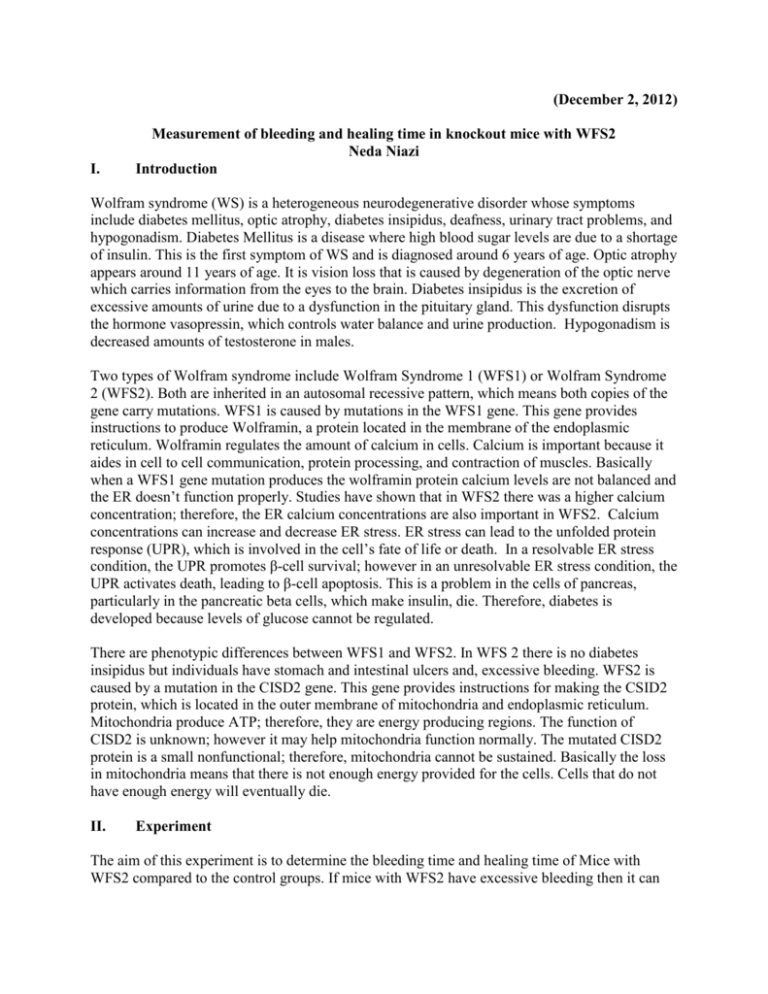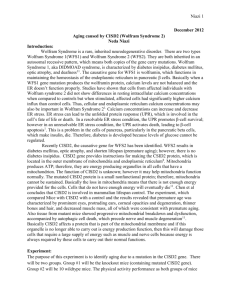Excessive bleeding in Wolfram Syndrome 2
advertisement

(December 2, 2012) I. Measurement of bleeding and healing time in knockout mice with WFS2 Neda Niazi Introduction Wolfram syndrome (WS) is a heterogeneous neurodegenerative disorder whose symptoms include diabetes mellitus, optic atrophy, diabetes insipidus, deafness, urinary tract problems, and hypogonadism. Diabetes Mellitus is a disease where high blood sugar levels are due to a shortage of insulin. This is the first symptom of WS and is diagnosed around 6 years of age. Optic atrophy appears around 11 years of age. It is vision loss that is caused by degeneration of the optic nerve which carries information from the eyes to the brain. Diabetes insipidus is the excretion of excessive amounts of urine due to a dysfunction in the pituitary gland. This dysfunction disrupts the hormone vasopressin, which controls water balance and urine production. Hypogonadism is decreased amounts of testosterone in males. Two types of Wolfram syndrome include Wolfram Syndrome 1 (WFS1) or Wolfram Syndrome 2 (WFS2). Both are inherited in an autosomal recessive pattern, which means both copies of the gene carry mutations. WFS1 is caused by mutations in the WFS1 gene. This gene provides instructions to produce Wolframin, a protein located in the membrane of the endoplasmic reticulum. Wolframin regulates the amount of calcium in cells. Calcium is important because it aides in cell to cell communication, protein processing, and contraction of muscles. Basically when a WFS1 gene mutation produces the wolframin protein calcium levels are not balanced and the ER doesn’t function properly. Studies have shown that in WFS2 there was a higher calcium concentration; therefore, the ER calcium concentrations are also important in WFS2. Calcium concentrations can increase and decrease ER stress. ER stress can lead to the unfolded protein response (UPR), which is involved in the cell’s fate of life or death. In a resolvable ER stress condition, the UPR promotes β-cell survival; however in an unresolvable ER stress condition, the UPR activates death, leading to β-cell apoptosis. This is a problem in the cells of pancreas, particularly in the pancreatic beta cells, which make insulin, die. Therefore, diabetes is developed because levels of glucose cannot be regulated. There are phenotypic differences between WFS1 and WFS2. In WFS 2 there is no diabetes insipidus but individuals have stomach and intestinal ulcers and, excessive bleeding. WFS2 is caused by a mutation in the CISD2 gene. This gene provides instructions for making the CSID2 protein, which is located in the outer membrane of mitochondria and endoplasmic reticulum. Mitochondria produce ATP; therefore, they are energy producing regions. The function of CISD2 is unknown; however it may help mitochondria function normally. The mutated CISD2 protein is a small nonfunctional; therefore, mitochondria cannot be sustained. Basically the loss in mitochondria means that there is not enough energy provided for the cells. Cells that do not have enough energy will eventually die. II. Experiment The aim of this experiment is to determine the bleeding time and healing time of Mice with WFS2 compared to the control groups. If mice with WFS2 have excessive bleeding then it can be confirmed that excessive bleeding is a symptom of WFS2. If mice with WFS2 have a longer healing time than the control groups then I would expect it to use similar mechanisms as diseases such as diabetes, and hemophilia. There will be three groups. Group #1 will be the knockout mice (containing mutated CISD2 gene). Group #2 will be 10 wildtype mice and Group #3 will be 10 diabetic mice Groups: 10 knockout mice (containing mutated CISD2 gene), 10 healthy mice that do not have Wolfram syndrome, and 10 nonobese diabetic (NOD) mice. Nonobese Diabetic (NOD) mouse is a well known genetically homogenous animal (inbred) model of type 1 diabetes that is derived from a closed colony of Jcl:ICR. Mice are frequently used because of their similar genomes as well as low costs, high reproductive rates, and easy handling of the mice. II. Measure of bleeding time Bleeding time is only a measure of platelet function. The platelet plug is the first thing to form, and that is enough to stop the bleeding from the incision made at the beginning of the test. Therefore, higher bleeding time will show a decreased platelet function, which will lead to excessive bleeding. Mice should be anesthetized with isoflurane. Tubes of saline should be prewarmed to 37ºC and maintained at the temperature during measurement. Using a sharp razor or blade, a 7mm cut should be applied at the tip of the tail. The tail should immediately be inserted in the pre-warmed tube of saline. The stopclock should be started at the time. Results should be recorded. II. Healing Cuts should be left to heal and the amount of time it takes the cut to heal should also be recorded. Cuts should be checked on twice a day. III. Discussion If all goes well the knockout mice with WFS2 will have a longer bleeding time. However, I am not sure if the healing time will be longer than the control. Diabetic people take longer to heal because decreases blood flow, so injuries are slower to heal than in people who do not have the disease. However, if the knockout mice with WFS2 had a quicker healing time than Diabetic mice then maybe some factors of Diabetes are not evident. However, if the Knockout Mice with WFS2 has the slowest healing time then WFS2 prolongs healing time even more, which might mean that some factors of diabetes are worse. Amr S, Heisey, C., Zhang, M., Xia, X.-J., Shows, K.H., Ajlouni, K., Pandya, A., Satin, L.S., ElShanti, H., Shiang, R. (2007). A Homozygous Mutation in a Novel Zinc Finger Protein, ERIS, is Responsible for W olfram Syndrome 2. J Hum Genet 81:673-683, Epub 2007 August 20 Broze G, Yin Z, Lasky N (2001). A tail vein bleeding time model and delayed bleeding in hemophiliac mice. J Thrombosis and haemostasis. 85:747-800. Chen, Y, Wu, C, Kirby, R, et al. (2010). A role for the cisd2 gene in lifespan control and human disease. Annals of the New York Academy of Sciences, 1201, 58-64 Fonseca S, Gromada J, Urano F (2011) Endoplasmic reticulum stress and pancreatic β-cell death. J Biol Chem 22: 266-274. Ikegami H, Fujisawa T, Ogihara (2004).Mouse Models of Type 1 and Type 2 Diabetes Derived from the Same Closed Colony: Genetic Susceptibility Shared Between Two Types of Diabetes. J Institute for Laboratory Research. 45: 268-277. Kamel Ajlouni, et al. "Bleeding Tendency In Wolfram Syndrome: A Newly Identified Feature With Phenotype Genotype Correlation." European Journal Of Pediatrics 160.4 (2001): 243. Health Source: Nursing/Academic Edition. Web. 28 Nov. 2012 Kanki T, Daniel J. Klionsky (2009). Mitochondrial Abnormalities Drive Cell Death in Wolfram Syndrome 2. Cell Research. 19(9), 922-23. Rigoli, L, & Di Bella, C. (2012). Wolfram syndrome 1 and wolfram syndrome 2. Current opinion in pediatrics, 24(4), 512-517. Simmons, D. (2008) The use of animal models in studying genetic disease: transgenesis and induced mutation. Nature Education 1(1)







